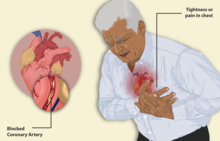
Back ذبحة صدرية لامستقرة Arabic Angina inestable Catalan آنژین ناپایدار Persian Angor instable French תעוקת לב לא יציבה HE Angina pektoris tidak stabil ID Angina instabile Italian Нестабильная стенокардия Russian อาการปวดเค้นไม่เสถียร Thai
| Unstable angina | |
|---|---|
| Other names | Crescendo angina |
 | |
| Illustration depicting angina | |
| Specialty | Cardiology |
| Symptoms | Chest pain or chest discomfort at rest or minimal exertion, or a new onset chest pain or discomfort on exertion. |
| Complications | Coronary artery disease |
Unstable angina is a type of angina pectoris[1] that is irregular or more easily provoked.[2] It is classified as a type of acute coronary syndrome.[3]
It can be difficult to distinguish unstable angina from non-ST elevation (non-Q wave) myocardial infarction.[4][5] They differ primarily in whether the ischemia is severe enough to cause sufficient damage to the heart's muscular cells to release detectable quantities of a marker of injury, typically troponin T or troponin I.[4][6] Unstable angina is considered to be present in patients with ischemic symptoms suggestive of an acute coronary syndrome and no change in troponin levels, with or without changes indicative of ischemia (e.g., ST segment depression or transient elevation or new T wave inversion) on electrocardiograms.[4]
- ^ Yeghiazarians Y, Braunstein JB, Askari A, Stone PH (January 2000). "Unstable angina pectoris". N. Engl. J. Med. 342 (2): 101–14. doi:10.1056/NEJM200001133420207. PMID 10631280.
- ^ "unstable angina" at Dorland's Medical Dictionary
- ^ Wiviott, S. D.; Braunwald, E (2004). "Unstable Angina and Non–ST-Segment Elevation Myocardial Infarction: Part I. Initial Evaluation and Management, and Hospital Care". American Family Physician. 70 (3): 525–32. PMID 15317439.
- ^ a b c Collet, Jean-Philippe; Thiele, Holger; Barbato, Emanuele; Barthélémy, Olivier; Bauersachs, Johann; et al. (2021-04-07). "2020 ESC Guidelines for the management of acute coronary syndromes in patients presenting without persistent ST-segment elevation". European Heart Journal. 42 (14): 1289–1367. doi:10.1093/eurheartj/ehaa575. ISSN 1522-9645. PMID 32860058.
Unstable angina is defined as myocardial ischaemia at rest or on minimal exertion in the absence of acute cardiomyocyte injury/necrosis. [...] Compared with NSTEMI patients, individuals with unstable angina do not experience acute cardiomyocyte injury/necrosis.
- ^ Gulati, Martha; Levy, Phillip D.; Mukherjee, Debabrata; Amsterdam, Ezra; Bhatt, Deepak L.; et al. (2021-11-30). "2021 AHA/ACC/ASE/CHEST/SAEM/SCCT/SCMR Guideline for the Evaluation and Diagnosis of Chest Pain: A Report of the American College of Cardiology/American Heart Association Joint Committee on Clinical Practice Guidelines". Circulation. 144 (22): e368–e454. doi:10.1161/CIR.0000000000001029. ISSN 0009-7322. PMID 34709879.
- ^ Barthélémy, Olivier; Jobs, Alexander; Meliga, Emanuele; et al. (2021-04-07). "Questions and answers on workup diagnosis and risk stratification: a companion document of the 2020 ESC Guidelines for the management of acute coronary syndromes in patients presenting without persistent ST-segment elevation". European Heart Journal. 42 (14): 1379–1386. doi:10.1093/eurheartj/ehaa602. ISSN 1522-9645. PMC 8026278. PMID 32860030.
NSTEMI is characterized by ischaemic symptoms associated with acute cardiomyocyte injury (=rise and/or fall in cardiac troponin T/I), while ischaemic symptoms at rest (or minimal effort) in the absence of acute cardiomyocyte injury define unstable angina. This translates into an increased risk of death in NSTEMI patients, while unstable angina patients are at relatively low short-term risk of death.
© MMXXIII Rich X Search. We shall prevail. All rights reserved. Rich X Search